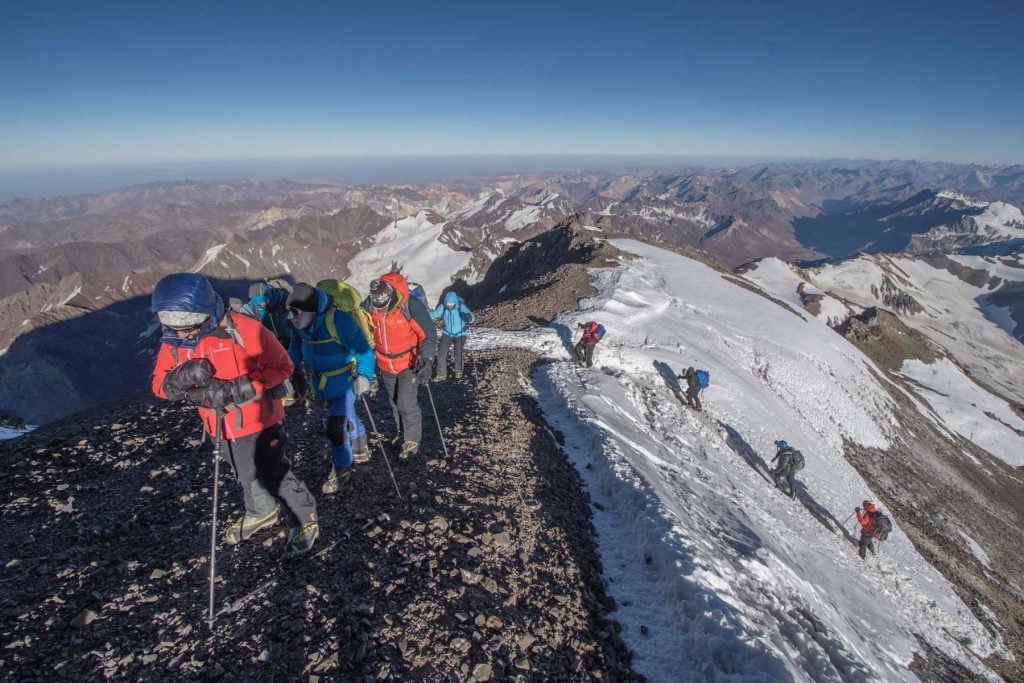For those looking to climb Aconcagua, timing is everything. As the highest peak in the Western Hemisphere, Aconcagua presents unique challenges that are heavily influenced by seasonal changes. At Aventuras Patagonicas, we guide climbers to the summit under the safest and most favorable weather conditions possible. Understanding the best times to undertake this epic journey can make all the difference in your experience and success.
Climbing Seasons: Understanding the Southern Hemisphere’s Summer
Aconcagua is located in Argentina, which means it experiences seasons opposite those in the Northern Hemisphere. The ideal months to attempt to summit Aconcagua are from December to March, during the Southern Hemisphere’s summer. This period generally offers the most stable weather conditions, essential for a safe and enjoyable climb.
Summer on Aconcagua, however, is markedly different from the balmy summers you might find elsewhere. Even during these warmer months, the weather on Aconcagua can be extremely variable and challenging.
Weather Conditions from Basecamp to Summit
The journey from basecamp to the summit of Aconcagua exposes climbers to a wide range of weather conditions. At basecamp on both sides of the mountain, the weather can be quite mild with temperatures comfortable enough for lightweight hiking gear during the day. However, as you ascend, temperatures can plummet, and the climate becomes more severe.
The summit itself can be brutally cold with temperatures dropping as low as -30°C (-22°F), especially early in the morning or late at night. Wind speeds can also accelerate significantly, occasionally reaching over 100 km/h (60 mph), which adds an extra layer of challenge to the climb. When winds rise well beyond 70km/h (44 mph), we start to consider it unsafe to climb Aconcagua. Beyond 100 km/h, you start to get into the territory of hurricane-force winds, which we would strongly advise all climbers to avoid. Sections of the summit climb can be risky especially if one falls. We believe climbers must be prepared for extreme cold and potentially fierce winds as they approach the summit.
The Best Possible Weather Conditions
During the summer months, the weather is generally more favorable for climbing, with clearer skies and less precipitation. This is the time when you’re most likely to experience what could be termed ‘good’ weather on Aconcagua. However, even during this season, weather conditions can be unpredictable, and climbers must be prepared for sudden changes.
Preparing for the Worst
While the summer months offer the best opportunity for mild weather, they can also bring days of significant snowfall, whiteouts, and prolonged high winds. These conditions can halt your progress and, in some cases, require you to turn back if the weather becomes too dangerous. We emphasize the importance of flexibility in our climbing schedule to accommodate delays due to adverse weather, by having multiple buffer days to allow us to wait for the best weather window.
Weather Windows: Key to Summit Success
One of the most critical concepts in high-altitude mountaineering is the “weather window.” This term refers to a short period when the weather is stable enough to attempt a summit push. Identifying and taking advantage of these windows is crucial to a successful climb. Our experienced guides are skilled at interpreting weather patterns and forecasts to make the best judgment calls on when to push for the summit.
Weather windows can appear and disappear quickly, and successful summit attempts hinge on being ready to move when the opportunity arises. This readiness involves having acclimatized adequately and being physically and mentally prepared to endure long, strenuous hours under potentially harsh conditions.
Why Choose Aventuras Patagonicas?
At Aventuras Patagonicas, we have 40 years of experience in guiding climbers to the summit of Aconcagua and identifying the most favorable conditions. Our expertise not only lies in our mountaineering skills but also in our ability to provide climbers with the safest, most enjoyable experience possible. We monitor the weather closely and make informed decisions that have led to a high success rate for our clients.
In 40 years of climbing on Aconcagua, we have not seen much statistical difference in success between climbing in December, January or February. However, the weather is often significantly worse with much fewer weather windows either side of the three month climbing season. This is why we only offer expedition dates with the opportunity to summit in December, January or February.
We understand that deciding to climb Aconcagua is a significant commitment, both physically and financially. Being physically prepared for the expedition is just as important as choosing the right time to climb. By planning your climb during the optimal months and with a reliable guiding company like Aventuras Patagonicas, you maximize your chances of a successful and rewarding experience.
Ready to embark on this incredible adventure? Check out our different Aconcagua expedition options to see how we can help you achieve your dream of standing on the top of the Americas. When you climb Aconcagua with us, your safety and success are our top priorities.

